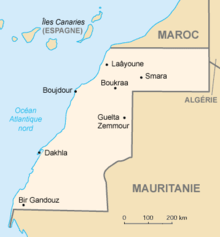Guelta Zemmur

Guelta Zemmur , also Guelta Zemour , Moroccan tamazight for 'olive tree pond ', is a small town in the part of Western Sahara that is under Moroccan administration .
The place is located around a guelta that is filled by rainwater that stays in the basin for a long time. The course was for centuries as a camp of Sahrawis - nomads used.
history
Under the Madrid Agreement of 1975, Morocco and Mauritania took control of the former Spanish colony . After the Spanish soldiers evacuated the remote outpost in June 1975, the Frente Polisario built a military base and an administration. At the beginning of the Western Sahara conflict, the place served as a contact point for the fleeing residents on their way to the Sahraui refugee camps in Tindouf, Algeria . In February 1976 at least 10,000 refugees had gathered in Guelta Zemmour and in Oum Dreiga further south. Some of the refugees died in the following two months from Moroccan bombing, which included napalm .
In 1981 the place was in Moroccan hands when the Polisario attacked the 2,600 soldiers of the 4th Infantry Regiment stationed here on March 24th to 25th. In the heaviest attack on October 13, 1981, the Polisario attackers shot down three aircraft and are believed to have killed well over 100 Moroccans. With 230 prisoners and a large number of captured weapons, they fled to the mountains on October 16. The fighting continued during the month until the Moroccan Armed Forces (Forces Armées Royales) withdrew completely from Guelta Zemmur on November 7, 1981. The Moroccan King Hassan II accused the Mauritanian military regime that the Polisario had operated from Mauritania with their approval. Mohamed Khouna Ould Haidalla rejected any involvement and opposed a withdrawal of the fighters to his country.
The city has been west of the Moroccan wall since September 1985 and is administered by Morocco, which maintains a military base here.
sons and daughters of the town
- Mohammed Daddach (* 1957), the longest-serving political prisoner in Morocco
literature
- Tony Hodges: Western Sahara. The Roots of a Desert War. Lawrence Hill Company, Westport, Connecticut 1983.
Individual evidence
Coordinates: 25 ° 9 ′ N , 12 ° 22 ′ W